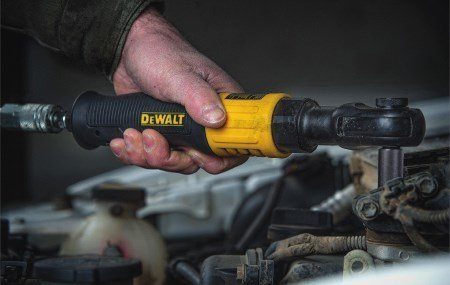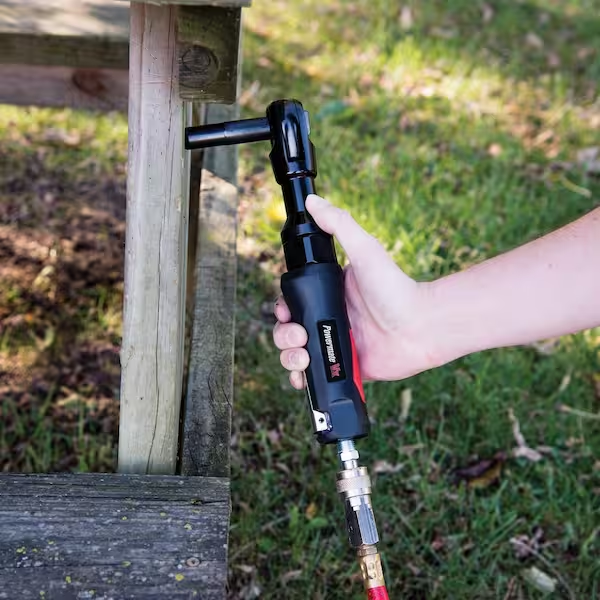Navigating the Pros and Cons of Air Ratchets in the Toolbox
Discover the power and limitations of air ratchets, essential pneumatic tools in automotive and maintenance. While offering high torque and rapid operation, their dependency on compressed air can pose mobility challenges. Explore when and where these tools shine, and when alternatives like cordless electric ratchets may be preferred.
The Power of Air Ratchets: Pros and Cons

In the world of mechanics and automotive repair, efficiency and precision are paramount. One tool that has become indispensable in the toolkit of professionals and DIY enthusiasts alike is the air ratchet. This compact yet powerful device has revolutionized the way fastening tasks are approached, providing a seamless blend of speed and accuracy.
An air ratchet is a pneumatic tool designed to tighten or loosen fasteners quickly and efficiently. It operates using compressed air, allowing for rapid rotational movements without the need for manual effort. The tool typically features a ratcheting mechanism, enabling users to turn fasteners in tight spaces with ease. This makes it an invaluable asset in automotive repair, construction, and various other mechanical applications.
Uses of Air Ratchets:
- Automotive Repair: One of the primary applications of air ratchets is in automotive repair. Their ability to navigate tight spaces, combined with the speed of operation, makes them ideal for tasks like removing or installing nuts and bolts in engine compartments or wheel wells.
- Construction: In construction settings, air ratchets excel at tasks such as assembling scaffolding, securing framing components, or attaching fasteners in areas where manual tools might struggle to reach.
- Maintenance Work: Whether it's tightening bolts in industrial machinery or assembling furniture, air ratchets prove to be versatile tools that streamline a variety of maintenance tasks.
Benefits of Air Ratchets:
- Speed and Efficiency: The primary advantage of air ratchets is their speed. They significantly reduce the time required for fastening tasks compared to manual tools, increasing overall efficiency.
- Versatility: The compact design and ability to operate in tight spaces make air ratchets versatile tools suitable for a wide range of applications.
- Reduced Physical Strain: As these tools operate on compressed air, users experience less physical strain compared to manual wrenches, contributing to a more comfortable working experience.
FAQ
What is a ratchet power tool?
A ratchet power tool is a type of mechanical device designed to facilitate the tightening or loosening of fasteners such as nuts and bolts. Unlike traditional manual ratchets, which require manual effort to operate, ratchet power tools are powered by an external energy source, commonly electricity or compressed air. These tools are known for their efficiency, speed, and the ability to tackle fastening tasks in tight spaces.
There are various types of ratchet power tools, each catering to specific applications and industries. The two main categories are electric ratchets and pneumatic (air) ratchets.
- Electric Ratchets:
- Power Source: Electric ratchets are powered by electricity, typically through a cord that connects to an electrical outlet. Some models also come with rechargeable batteries for greater mobility.
- Applications: Electric ratchets are commonly used in automotive repair, construction, and maintenance tasks. They are versatile tools suitable for various fastening applications.
- Pneumatic (Air) Ratchets:
- Power Source: Pneumatic ratchets operate using compressed air. They are connected to an air compressor via a hose, and the compressed air powers the tool's rotational movement.
- Applications: Pneumatic ratchets are widely used in automotive repair and assembly, as well as in industries where a compressed air system is readily available. They are valued for their high torque output and ability to deliver rapid, continuous rotations.
What are the 3 different parts of a ratchet?
A typical ratchet tool consists of three main parts:
- Handle:
- The handle is the part of the ratchet that the user grips and operates. It often has a comfortable grip or ergonomic design to make it easier to handle and use for extended periods.
- On the handle, there is a switch or lever that controls the direction of rotation. This switch allows the user to set the ratchet to either tighten or loosen fasteners.
- Head:
- The head of the ratchet contains the mechanism responsible for the ratcheting action. It typically houses a gear and pawl system that allows the tool to rotate in one direction while preventing rotation in the opposite direction.
- The head also holds the socket attachment, which is used to connect the ratchet to different-sized sockets. This makes the ratchet a versatile tool that can accommodate various fastener sizes.
- Drive:
- The drive is the square-shaped or hexagonal end of the ratchet that connects to sockets and other accessories. Common drive sizes include 1/4 inch, 3/8 inch, and 1/2 inch, referring to the size of the square or hexagonal opening.
- The drive size determines the range of sockets and extensions that can be used with the ratchet. Larger drive sizes are typically capable of handling larger and more robust fasteners.
What is the most commonly used ratchet?
The most commonly used ratchet sizes are 1/4 inch, 3/8 inch, and 1/2 inch drive ratchets. Each size has its own specific applications and is commonly found in various tool sets. Let's briefly explore each:
- 1/4 Inch Drive Ratchet:
- Applications: 1/4 inch drive ratchets are commonly used for smaller fasteners and applications where space is limited. They are often employed in precision work, such as in electronics, appliances, and light automotive tasks.
- Benefits: These ratchets are lightweight and maneuverable, making them suitable for delicate work.
- 3/8 Inch Drive Ratchet:
- Applications: 3/8 inch drive ratchets are versatile and are suitable for a wide range of applications, including automotive repair, general construction, and maintenance tasks. They strike a balance between the smaller 1/4 inch drive and the larger 1/2 inch drive ratchets.
- Benefits: The 3/8 inch drive size is a go-to choice for many mechanics and DIY enthusiasts due to its versatility.
- 1/2 Inch Drive Ratchet:
- Applications: 1/2 inch drive ratchets are commonly used for heavier-duty applications, such as working on larger vehicles, construction equipment, and industrial machinery. They are well-suited for tasks that require higher torque.
- Benefits: These ratchets can handle larger fasteners and provide more leverage, making them ideal for heavy-duty applications.
What is an example of a ratchet?
An example of a ratchet is the commonly used hand tool known as a socket wrench. A socket wrench typically consists of a handle, a ratcheting mechanism, and a socket attached to the end of the wrench. This tool allows for the tightening or loosening of fasteners such as nuts and bolts. The ratcheting mechanism enables the user to turn the fastener in one direction while the tool resets for the next turn in the opposite direction, making it a highly efficient tool for tasks that involve repetitive turning.
Here's a brief description of the components of a socket wrench:
- Handle: The handle is the part of the tool that the user grips and operates. It often has a comfortable grip for ease of use.
- Head: The head contains the ratcheting mechanism, which includes gears and a pawl. This mechanism allows the socket wrench to turn the fastener in one direction and then reset for the next turn in the opposite direction.
- Socket: The socket is attached to the end of the wrench and fits onto the fastener. Sockets come in various sizes to accommodate different fastener sizes.
What are the 2 types of ratchet?
The two main types of ratchets are manual ratchets and power ratchets. These categories differ in how they are powered and the type of work they are commonly used for.
- Manual Ratchets:
- Power Source: Manual ratchets are powered by the user's physical effort. The user grips the handle and manually operates the ratcheting mechanism to tighten or loosen fasteners.
- Applications: Manual ratchets are versatile tools used in various applications, from automotive repair to construction and general maintenance. They are suitable for tasks where power tools may not be practical or where precision and control are essential.
- Advantages: Manual ratchets are portable, do not require an external power source, and are typically more straightforward to use for tasks that demand careful, controlled movement.
- Power Ratchets:
- Power Source: Power ratchets are motorized tools that use external power sources, such as electricity or compressed air, to drive the ratcheting mechanism. This eliminates the need for manual effort in turning the handle.
- Applications: Power ratchets are often used in applications where efficiency and speed are crucial. They are popular in automotive repair, construction, and other tasks involving a high volume of fasteners.
- Advantages: Power ratchets can significantly reduce the time and physical effort required for fastening tasks. They are particularly beneficial for repetitive or heavy-duty applications.
Both manual and power ratchets have their advantages and are chosen based on the specific requirements of the task at hand. Manual ratchets are valued for their simplicity, portability, and suitability for tasks that demand precision, while power ratchets excel in scenarios where speed and efficiency are paramount.
Is an air ratchet a power tool?
An air ratchet is indeed a power tool. An air ratchet is a type of pneumatic tool that operates using compressed air as its power source. It is commonly used in automotive repair, construction, and maintenance for quickly tightening or loosening fasteners.
The key components of an air ratchet include a handle, a ratcheting head with a mechanism for directional control, and a drive that accepts sockets. The air ratchet is connected to an air compressor via a hose, and the compressed air powers the tool's rotational movement.
As a power tool, the air ratchet offers several advantages, including high torque output, rapid operation, and the ability to access tight spaces. It is often preferred in professional settings where a compressed air system is readily available and where the efficiency and speed of a power tool are essential.
What kind of tool is air ratchet?
An air ratchet is a pneumatic tool. Pneumatic tools, also known as air tools, are powered by compressed air. In the case of an air ratchet, the tool is connected to an air compressor through a hose. The compressed air is then used to drive the internal mechanisms of the ratchet, enabling it to quickly tighten or loosen fasteners.
Pneumatic tools, including air ratchets, are widely used in various industries, such as automotive repair, construction, manufacturing, and maintenance. They are valued for their power, efficiency, and versatility in applications where a high torque output and rapid operation are crucial. The availability of compressed air in many industrial settings makes pneumatic tools like air ratchets popular choices for professionals who require reliable and efficient tools for their work.
What is one disadvantage of using an air ratchet?
One disadvantage of using an air ratchet is its dependency on a compressed air source. Unlike corded or cordless electric ratchets that can operate independently, air ratchets require a connection to an air compressor through a hose. This dependence on an external air source can introduce some limitations and challenges:
- Mobility and Portability:
- Air ratchets are tethered to an air compressor by a hose, limiting the tool's mobility and portability. This can be a drawback in situations where access to compressed air is restricted or where the tool needs to be used in locations without a nearby air source.
An air ratchet is a pneumatic tool powered by compressed air, commonly used in automotive repair and maintenance. While it offers high torque and rapid operation, a significant disadvantage is its dependency on an external air source. The tethering to an air compressor restricts mobility and portability, making it less suitable for situations where access to compressed air is limited or when working in remote locations. In such cases, alternative tools like cordless electric ratchets may be preferred for their independence from external power sources.







